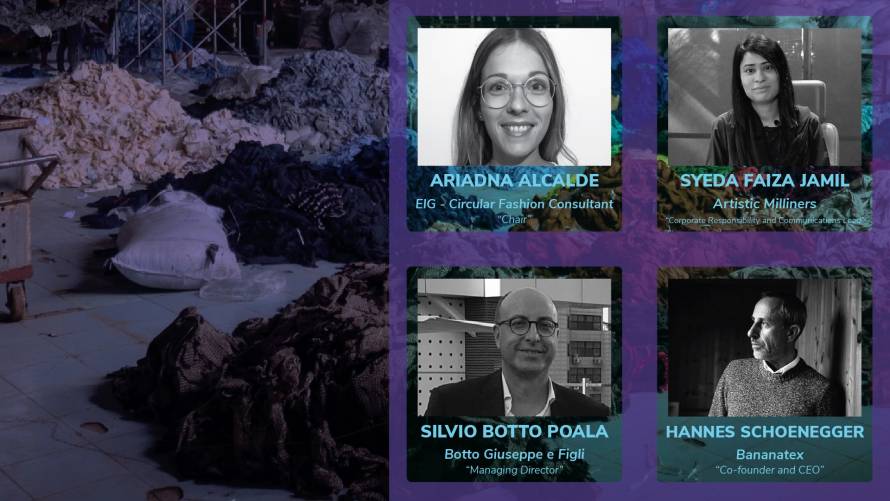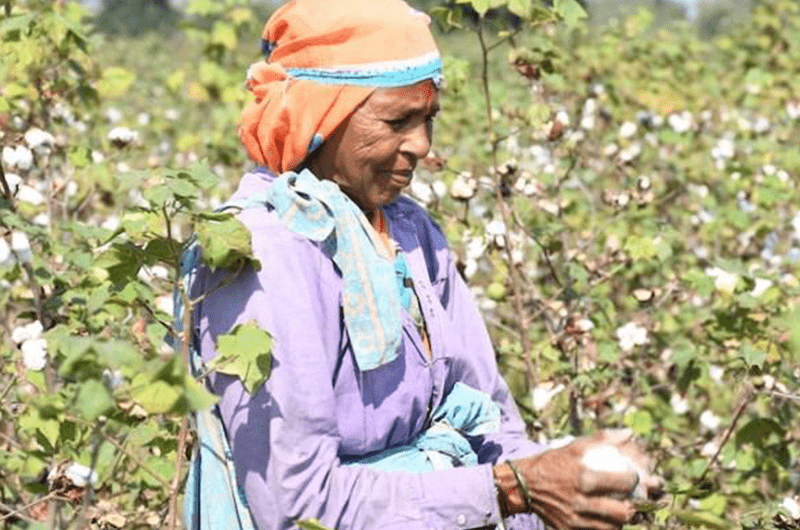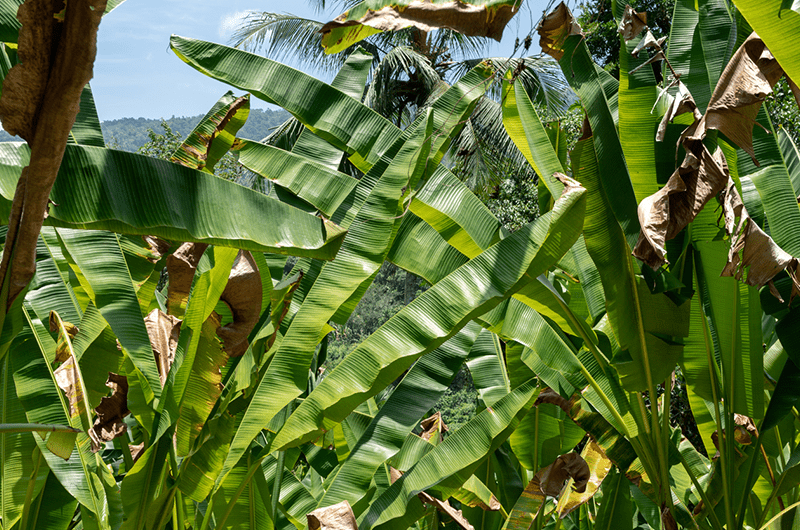
31 August 2021
Regeneration in the fashion industry
Roundtable: What's next on regenerative & fashion
What does regeneration in the fashion industry mean? How can fashion companies contribute to having a positive impact on the environment and the society?
Different stakeholders in the fashion industry are taking initiatives to restore and enrich the soils, clean water bodies and the air and help ecosystems become more resilient. Regeneration is becoming key in the transformation of the fashion industry.
The last 13th of July we had the opportunity to hear firsthand which actions different companies are undertaking to boost regeneration in the fashion industry. These were our three invited speakers: Syeda Faiza Jamil, Corporate Responsibility and Communications Lead at Artistic Milliners; Hannes Schoenegger, Co-Founder & CEO of Bananatex and Silvio Botto Poala, CEO at Botto Giuseppe e Figli.
From Organic to Regenerative: the key shift toward regeneration in the fashion industry
Syeda Faiza Jamil, from Artistic Milliners, believes organic agriculture is the future. As she said, organic agriculture doesn’t support synthetic or chemical fertilizers in pesticides, and it doesn’t allow the use of genetically modified seeds. This way of working with cotton allows the soil to grow healthily, encouraging biodiversity and rural farmer communities.
Organic is only one small part of how Artistic Milliners restore the soil to address the climate crisis. They understand it’s not enough and it’s impossible to talk about regeneration in the fashion industry only from garment onwards.
“Topsoil is the foundation of life on earth, topsoil is not dead, it’s alive” said Faiza. There’s a billion of organisms in just a teaspoon of topsoil. It is key to make the shift from feeding the plants to feeding the soil; and to do this the natural ecosystem diversity needs to be restored and protected. Also combining different kinds of livestock, allows for better results in terms of disease mitigation or encouraging more biodiversity.
Traditional and innovative fibers to enable regeneration in the fashion industry
Artistic Milliners is a Pakistani denim manufacturer with a long history in collaborating with NGO (WWF) and working towards empowerment of working women among others. They started working with local farmers to increase cultivation of organic and regenerative cotton for their products. This company wants to help farmers to make the “switch”: to start working together with nature to improve both the ecosystem and their own resiliency.
Bananatex was born with the idea of creating a natural fabric made of a rapidly renewable and naturally available source. They found a great one in the abaca tree, which was equally resistant to the synthetic fabrics commonly used. Their innovative material is made exclusively from this type of banana fibers. The Bananatex fabric is very strong and has a very high resilience. They started manufacturing bags two years ago and received a lot of requests from all kinds of industries who wanted to work with them.
Botto Giuseppe is an Italian high quality textile manufacturer. They produce high-end wool silk and cashmere yarns. Their work has been focused for many years on ensuring traceability of their fibers throughout the supply chain and progressively to ensure animal welfare as well. Now they support their suppliers to move further exploring how livestock can help restore soils while keeping the highest quality of fibers. We will explore it further in the near future.
All three companies understand that their business depends on this strong cooperation with nature and their stakeholders, mainly suppliers at this stage. Regeneration in the fashion industry is not only a trend, is a must.
How to fight plagues without pesticides?
Ecosystems successfully evolved along millions of years. They provided shelter and food for all their inhabitants until human intervention disrupted this balance. There are plants that can act as natural pesticides, like Artistic Milliners suppliers explained. They are made of native species which farmers can harvest. As Faiza said, these pesticides don’t harm biodiversity or the soil biome, they are part of it. Farmers have experienced the benefits of using natural pesticides by witnessing the decline of species in that area due to the use of industrial alternatives.
Hannes told us that, in some cases, even it’s not necessary to use natural pesticides. One of the most compelling properties of the Bananatex fiber is that there’s no fertilizers needed, not even additional water, no pesticides, it grows very naturally, and the cultivation happens in the permaculture so-called agroforestry. In addition, Abaca trees, are also helping reforestation because their strong roots keep soil from eroding.
Animals farming also have an impact on the health of the soil. As Silvio commented, it was thought that the animals could create more damage on the soil. Lately, it has been found that the problem isn’t the animals but the way these are managed. As Allan Savory said, “No resource can cause damage, only through how we manage our resources (nature) and our economy can we cause damage and especially at the scale of global desertification and climate change.”
What’s the impact on society of regenerative practices?
Regenerative practices also have a positive effect on our society. Companies, like Artistic Milliners, teach farmers different techniques to consider when they farm, so they can improve the quality of soils and their production. As Faiza explained, farmers are very respectful, attached to the lands that they have inherited, and so cautious about protecting health and believing that land is alive.
Bananatex also has a positive impact on the farming communities by giving stable incomes as the plant grows permanently in their ecosystem. They use the side stocks that are harvested so it’s a very stable ongoing process. Hannes explained that farmers have long-term, transparent, and fair contracts for the fibers they extract, although we must not forget it is still hard work for them.
Last but not least, for Silvio from Botto Giuseppe, working long term with the same farm it’s essential for creating a good relationship between all the stakeholders. The company also believes that sustainability is impossible to reach without transparency. They aren’t only a marketing point or trend but a lifestyle where all the stakeholders have to work together. Definitely, brand credibility improves when acting ethically and friendly to the environment.
Key practices of regenerative agriculture
There are five recognized principles of regenerative agriculture. The application of these five principles is very positive for soil health, biodiversity on the ground and the economic resilience of farming communities.
- Minimize soil disturbance: Tillage increases the concentration of nitrates in the soil, causes an enormous loss of nutrients, increases the likelihood of soil erosion and the loss of nutrients during the next rain and windstorm.
- Maximize crop diversity: Increasing soil biodiversity should be a priority. This practice will help the development of a diverse mix of plants from different ecological niches that will ultimately complement the growth of other plants in nutrient and nitrogen fixation.
- Keep the soil covered: To protect the topsoil, farmers recommend developing a soil cover with cover crops and grasses. It is very important that the soil is covered to prevent erosion.
- Maintain living root in the ground year-round: The living roots make the soil very useful. Planting cover crops immediately after harvesting the previous crop provides optimal photosynthesis and helps to fix atmospheric carbon dioxide and convert it into stable soil carbon.
- Integrate livestock: Intensive grazing, known as holistic management, is often applied to increase crop value and nutrient recycling through animal manure. Animal grazing increases the productivity of the farm and its products.
Our guests have informed and taught us a lot about how regeneration can be applied in the fashion industry. We are very grateful for our chat. We encourage you to share your experience and knowledge by commenting this article.
If you’re still interested in learning more about regenerative agriculture, we encourage you to visit the Savory Institute website: https://savory.global/
You can also read more about regeneration in the fashion industry by reading about Regenerative fashion to help the planet or watching our round table here.


